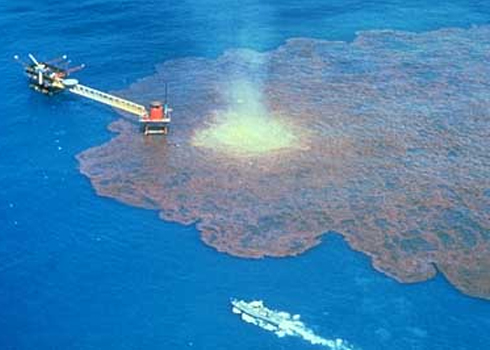The BP oil spill has been called an “unprecedented disaster” by both the president and BP’s top executive. But the Deepwater Horizon catastrophe has echoes of a 1979 spill, when a rig in the southern Gulf exploded after the blowout preventer failed.
Thirty-one years later, we haven’t come that far technologically with how we deal with underwater oil drilling spills. The Mexican company running the Ixtoc I rig attempted a slew of now-familiar remedies — they pumped mud into the well, capped it with a metal “sombrero,” shot lead balls into the well and drilled relief wells — but it took 10 months to stop the leak even though the drilling was taking place just 160 feet below the surface.
The Deepwater Horizon, which blew on April 20, was drilling 5,000 feet underwater.
The story of the Ixtoc disaster, one of the worst in drilling history, began on June 3, 1979. The Ixtoc was an exploratory well drilled in the oil-rich southern Gulf by Pemex, the Mexican state oil company. It exploded after the drilling mud, used as a counterbalance to pressure from natural gas, started escaping through cracks in the rock. Workers tried to plug the cracks, but the mud began surging back onto the rig, followed by oil and natural gas, which ignited. The crew tried to activate the blowout preventer, which, like the one on the Horizon, would have sheared off the drill pipes and sealed them shut. But, like the Horizon’s, it didn’t work.
Fortunately, unlike the Horizon, no lives were lost aboard the Ixtoc.
Pemex estimated that 475,000 metric tons of oil — some 3.5 million barrels — poured into the Gulf before the leak was finally plugged on March 23, 1980. The broken well initially spewed some 30,000 barrels a day and, according to Pemex, the rate dwindled to less than 2,000 barrels as the months went on. But U.S. scientists estimated that the rate was closer to a steady 50,000 barrels a day.
For comparison, the BP well is leaking at an estimated 12,000 to 19,000 barrels a day. If the BP well leaks for 10 months at that rate, the total oil leaked will reach 3.6 million to 5.6 million barrels.
Pemex’s attempts to stop the leak will sound familiar to those following the BP response.
The company sent divers down to try to shut off the well, and BP sent submersible robots, both to no avail. Pemex, like BP, also sprayed the slick with dispersants, burned off some of the oil and gas and collected contaminated water with tankers.
Pemex pumped mud into the well in July 1979, a measure they claimed cut the leak to 20,000 barrels a day. BP tried the same last week in an operation called “top kill.” It failed.
Like BP’s junk shot, in which the company tried to block the leaking pipe with debris, Pemex shot lead balls into their open pipe. They had more success than BP, claiming the measure cut the leak down to 10,000 barrels a day.
Pemex also used containment domes, but instead of BP’s “top hat,” Pemex dubbed their dome “Operation Sombrero.” After a month of false starts and bad weather, Pemex successfully lowered the sombrero. They said the dome caught 6,500 barrels a day.
Throughout the months of attempts, Pemex was also drilling two relief wells. The first was completed in the late fall, and workers began pumping salt water and other liquids into it in order to relieve pressure.
It took until March of 1980 for the pressure had subsided enough to allow Pemex to pump cement into the well, creating a 1,650-foot-long plug. The leak finally stopped on March 23, 1980, some 10 months after it began. An estimated 3 million to 3.5 million total barrels of oil were spilled into the Gulf.
The next step for BP is lowering another containment dome. But government officials say the leak will likely continue until at least August, when BP expects to finish two relief wells. Drilling could be complicated, however, by what’s expected to be an active hurricane season.
The Ixtoc disaster affected 162 miles of Texas coastline and 1,421 birds were found with oiled feathers and feet, according to the NOAA. The U.S. commercial fishing industry was negligibly affected by the earlier spill, according to a report by the Bureau of Land Management. Conversely, some 25 percent of the Gulf has been closed to fishermen due to the BP spill.
The Ixtoc spill did cause Texas tourism to take a hit, however. The BLM estimated a seven to 10 percent decrease, while local officials claimed a 60 percent hit. U.S. businesses sued Mexico for more than $300 million in damages, but Mexico claimed sovereign immunity and refused to pay.
The effects to Texas were mitigated, however, because officials had two months to prepare boom and barrier islands before the oil hit.









